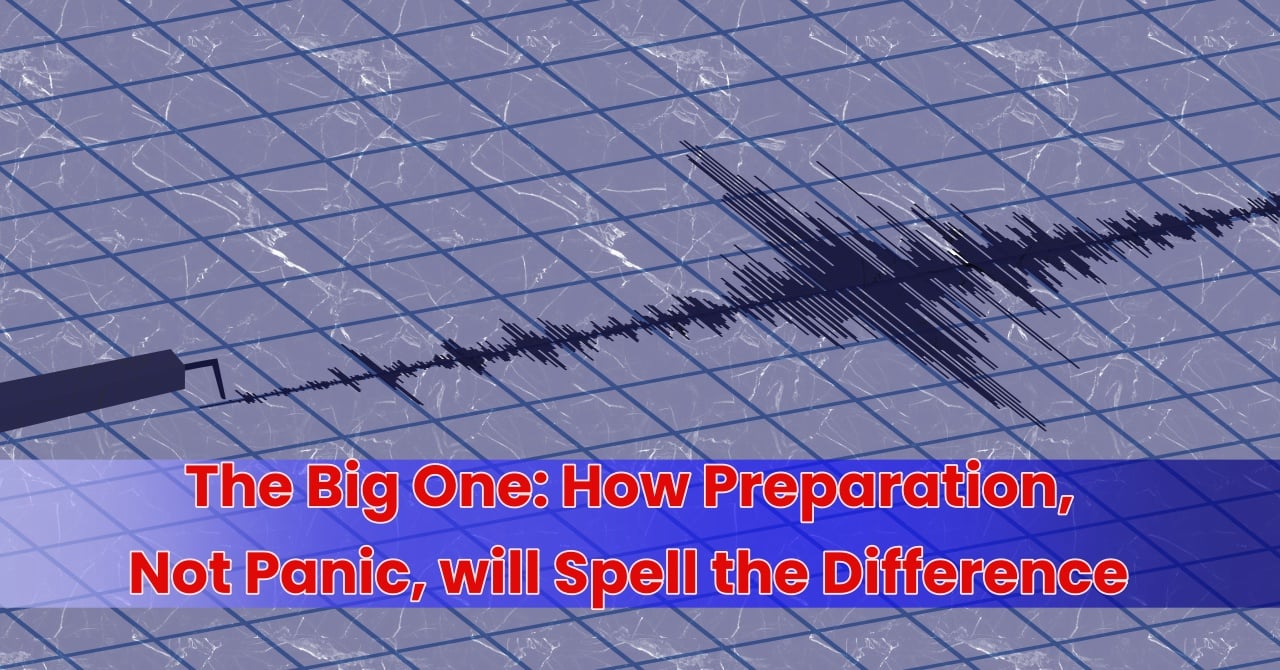In the past months, several strong earthquakes have shaken different parts of the Philippines—from Mindanao to Central Luzon. These tremors remind us that our country sits right on the Pacific Ring of Fire, where earthquakes are a natural part of life.
While scientists have not linked these quakes directly to the so-called “Big One,” they do highlight a reality we can’t ignore: our islands are crisscrossed by active faults, including the West Valley Fault. These small reminders are not meant to cause fear—but to strengthen our awareness.
Preparedness, not panic, is key to safety and survival. Earthquakes are unpredictable, but how we respond before, during, and after one can make all the difference. And for Filipinos, that response has always been rooted in three strengths: faith, education, and preparedness.

What Is the “Big One”?
The “Big One” refers to a possible magnitude 7.2 earthquake that could occur if the West Valley Fault (WVF) moves in a major way. It’s not a prophecy or prediction—it’s a scientific scenario based on fault studies and earthquake history in Luzon.
The WVF crosses several cities—Quezon City, Marikina, Pasig, Makati, Taguig, and Muntinlupa—and extends into Bulacan, Rizal, Cavite, and Laguna. Scientists estimate that this fault shifts roughly every 400 to 600 years. The last major movement happened in 1658, which means the probability increases as time passes.
What the Studies Say
A 2004 study by PHIVOLCS, JICA, and MMDA projected that a magnitude 7.2 quake could result in:
- 33,500 deaths
- 113,600 injuries
- Widespread fires and infrastructure collapse in Metro Manila
Those estimates were based on the 2004 population. With today’s denser communities and taller structures, updated models are being developed to reflect the current risks.
The earthquake could also trigger liquefaction, landslides, and fires caused by ruptured gas lines. Some scientists add that strong quakes might influence nearby volcanic activity, such as unrest in Taal Volcano.
What We Don’t Know
No one—not even scientists—can predict when the next big earthquake will strike.
PHIVOLCS stresses that no existing technology can forecast the day, year, or decade of a fault movement.
That’s why the “Big One” should never be treated as a doomsday prophecy.
It’s a reminder—an evidence-based scenario designed to strengthen awareness, safety, and resilience.
Why the “Big One” Is a Real Threat
The Philippines sits in the Pacific Ring of Fire, where tectonic plates constantly shift. On average, our country records 30 earthquakes a day, though most are too weak to feel.
But history reminds us to take the strong ones seriously. The 1990 Luzon Earthquake (magnitude 7.7) destroyed hundreds of buildings and killed over 1,600 people. The West Valley Fault itself has produced major quakes centuries ago that reshaped areas of Marikina, Taguig, and Laguna.
Dr. Renato Solidum Jr., Secretary of the DOST and PHIVOLCS expert, often says:
“Preparedness is not about fear—it’s about responsibility. Education and faith must guide our actions.”
Even Filipinos living far from Metro Manila should care. A major quake could affect power grids, water systems, and communication lines across Luzon. And for many, it’s also about concern for loved ones who live or work in fault-line areas.
Faith, Education, and Preparedness: Our Strongest Shield
In moments of uncertainty, Filipinos turn to what has always grounded us—faith.
But faith is not the opposite of preparation; it gives it meaning.
- Prayer reminds us of hope even when the future feels uncertain.
- Education empowers us with the knowledge to protect our families.
- Preparedness transforms fear into action and responsibility.
In every household, prayer can begin every family meeting about safety. Schools and barangays can blend earthquake drills with values education, reminding everyone that caring for others is part of our faith in action.
When faith and readiness work together, communities grow stronger—not just in spirit, but in safety.
Family and Community Earthquake Preparedness Guide
Before an Earthquake
- Know your hazards: Check if your home is near a fault using HazardHunterPH.
- Strengthen your home: Follow building codes; consult engineers if needed.
- Prepare a Go-Bag: Include water, food, flashlight, first aid kit, whistle, IDs, and medicines.
- Secure your space: Fasten furniture, frames, and shelves.
- Plan with your family: Assign roles, identify safe spots, and agree on meeting points.
- Pray together: Ask for guidance, calmness, and protection as you prepare.
During an Earthquake
- Drop, Cover, and Hold: Drop to the ground, take cover, and hold on.
- Avoid windows and hanging objects.
- If outside: Move to open areas, away from power lines.
- If driving: Pull over safely and stay inside the vehicle.
After an Earthquake
- Check for injuries and structural damage.
- Evacuate calmly if unsafe.
- Expect aftershocks—stay alert.
- Listen to verified news or LGU announcements.
- Help neighbors, especially the elderly and PWDs.
- Offer prayers for safety, healing, and unity.
Building Resilient Communities
Preparedness starts at home—but true resilience begins with community cooperation.
🏘️ Barangay Actions
- Map the neighborhood: Identify vulnerable residents.
- Assign “buddies”: Neighbors check on each other.
- Pool resources: Share supplies like first aid kits and water containers.
- Organize drills: Join community ShakeDrills to practice evacuation routes.
- Encourage faith gatherings: Use chapel groups or church ministries to discuss safety awareness.
When we look after one another—with faith, knowledge, and readiness—we turn tragedy into testimony.
In Closing
The “Big One” is not a curse or a prediction—it’s a call to prepare.
Faith without action can lead to fear, but faith with preparation leads to peace.
Let’s pray, learn, and prepare—together.
Because a family that’s prepared is safe,
and a community anchored in faith is unshakable.
